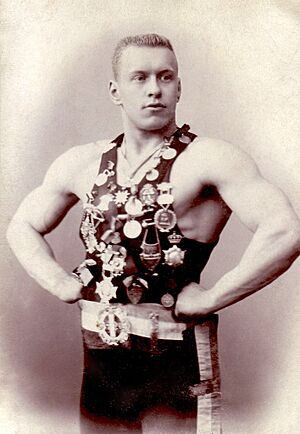Georg Lurich facts for kids
Quick facts for kids Georg Lurich |
|
|---|---|

Georg Lurich circa 1895
|
|
| Born | 22 April 1876 Väike-Maarja, Governorate of Estonia, Russian Empire |
| Died | 20 January 1920 (aged 43) Armavir, Russian Soviet Federative Socialist Republic |
| Professional wrestling career | |
| Debut | 1895 |
Georg Lurich (born April 22, 1876 – died January 20, 1920) was a famous Estonian wrestler and strongman from the early 1900s. He was also a coach for other strong Estonian athletes like Georg Hackenschmidt and Aleksander Aberg.
Contents
Georg Lurich's Early Life
Georg Lurich was born on April 22, 1876, in a village called Väike-Maarja in what was then the Russian Empire. He was one of six children. His family's original last name was Luri.
Why Lurich Changed His Name
His family changed their last name to Lurich. They did this because they switched churches. They moved from an Estonian church to a German one. They thought this would give their children better chances for school. Even with the new name, Georg faced bullying from his German schoolmates. This tough experience made him want to become strong. He learned how to train his body by reading German books. Georg started doing sports when he was very young.
Becoming a Professional Athlete
After finishing school in Tallinn in 1894, Georg went to St. Petersburg, Russia. There, he trained in weightlifting and wrestling. His coach was a Polish athlete named Dr. Władysław Krajewski. Lurich performed in St. Petersburg's parks. He competed against local wrestlers and showed off his strength. He did lifting demonstrations with another strongman, Gustav Boesberg. People loved watching him, and his popularity grew. This made him decide to become a professional athlete.
Lurich's Impact in Estonia
Georg Lurich became the first Estonian to set world records in weightlifting. People in Estonia were very excited to watch his matches. His fame in his home country soared. From 1897 to 1898, Lurich traveled all over Estonia. His success helped make sports popular there. Many new sports clubs were started. In 1896, Lurich became friends with an 18-year-old Estonian named George Hackenschmidt. Lurich began to train him. Hackenschmidt later became very famous in weightlifting and wrestling too.
Travels and Final Days
Before World War I, Lurich and his friend, fellow Estonian wrestler Aleksander Aberg, traveled to the United States. They performed for American audiences. Lurich competed in freestyle wrestling matches in the United States from 1913 to 1917. In 1913, Lurich wrestled the American world wrestling champion, Frank Gotch, in Kansas City. Lurich lost this match, which was Gotch's last one.
Journey Home and Challenges
After their time abroad, Lurich and Aberg returned home in 1917. They traveled through Japan, China, and Russia. They arrived in Estonia in the autumn. They started a wrestling tournament in Tallinn, the capital city. However, the tournament had to stop because German troops were getting close. The two athletes then went to Saint Petersburg and later to southern Russia.
The Russian Civil War made it impossible to work in Saint Petersburg and Moscow. They hoped things would be better in the southern region, which was controlled by the White Army. But the war spread, and they had to flee deeper into Russia. They ended up stuck in a remote village called Armavir. Their plan was to leave Russia by boat across the Black Sea.
Tragic End in Armavir
Things became very difficult in Armavir in early 1920. The war reached the village, and it changed hands many times. Many people died, and there were many funerals. A warm winter led to an outbreak of typhoid fever. Because of the war, it was hard to get medical help. Lurich got sick first and died on January 20, 1920. He was 43 years old. Aberg also caught typhus but managed to get better. However, he recovered too quickly, caught pneumonia, and died on February 15, 1920. The two wrestlers were buried together in the German cemetery in Armavir.
Lurich's Lasting Legacy
After Georg Lurich's death, many Estonians began to tell stories about his amazing feats. These stories grew so much that Lurich became almost a mythical hero. Folk tales about him are still popular in rural Estonia today.
A Famous Folk Tale
Here is an example of a folk tale about Georg Lurich, shared by Estonian author Kalle Voolaid:
"One hot and sunny summer day Lurich had been sitting on a hill slope in Väike-Maarja and when the heat was becoming too much for him, he ran down into the valley to freshen himself up with cool spring water. While running he hit his foot against a rock and fell on all fours on the stone. Then he stood up, went to the spring, put his feet and hands in the spring and washed with spring water. That is where he got the great strength, he had taken that rock against which he had hit his foot, and played with it as if it were a potato. That rock is said to be still there on the edge of Väike-Maarja memorial hill, covered with moss."
Artistic Tributes
In 1912, an Estonian sculptor named Amandus Adamson created a bronze statue of Lurich. It was called "Champion" and won an artist contest at the 1912 Paris Olympics. Lurich also inspired another sculpture by Adamson. This was a plaster sculpture called "Kalevipoeg at the Gates of Hell" in 1922.
Remembering a Hero
Lurich is still one of the most loved figures in Estonia. Many tour groups visit his memorial stone in Väike-Maarja. The international Georg Lurich Memorial in Greco-Roman wrestling is held every year in Estonia since 1956. On April 22, 2018, a new statue of Lurich was unveiled in Väike-Maarja.
Championships and Accomplishments
- International Professional Wrestling Hall of Fame
- Class of 2023
See also
- List of premature professional wrestling deaths

